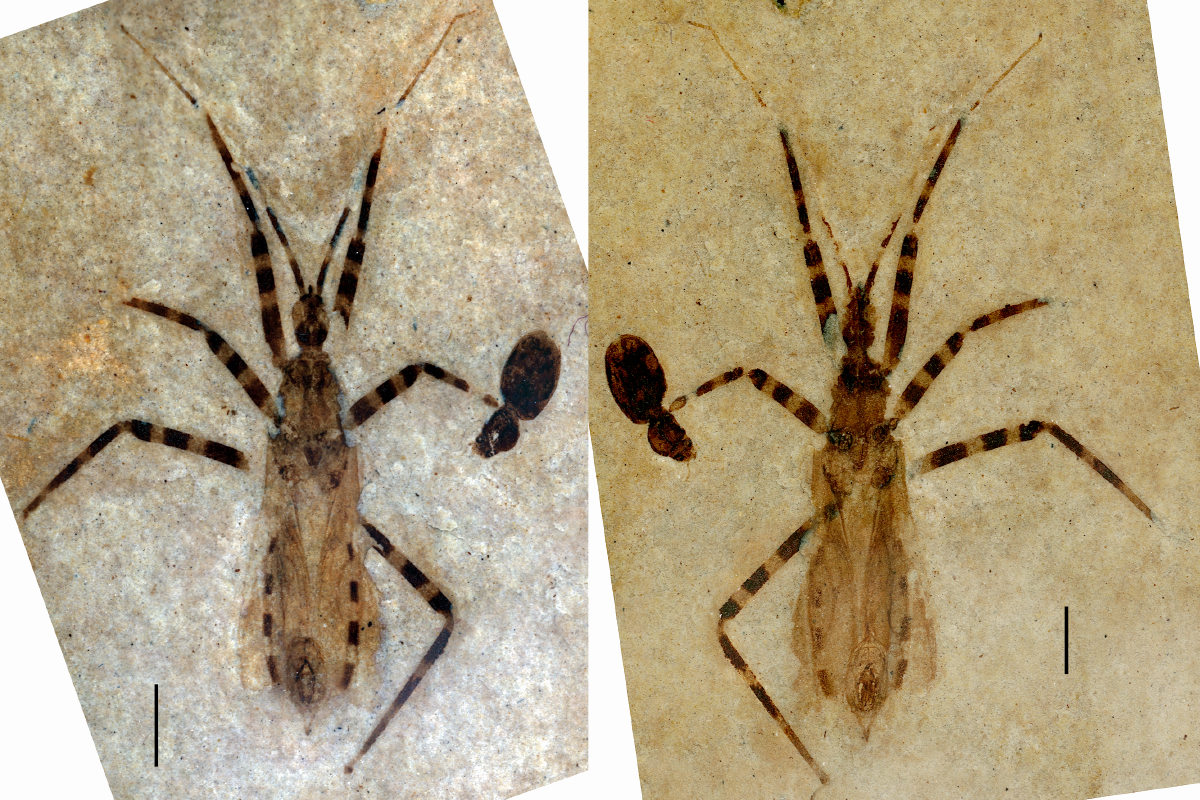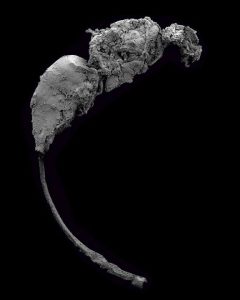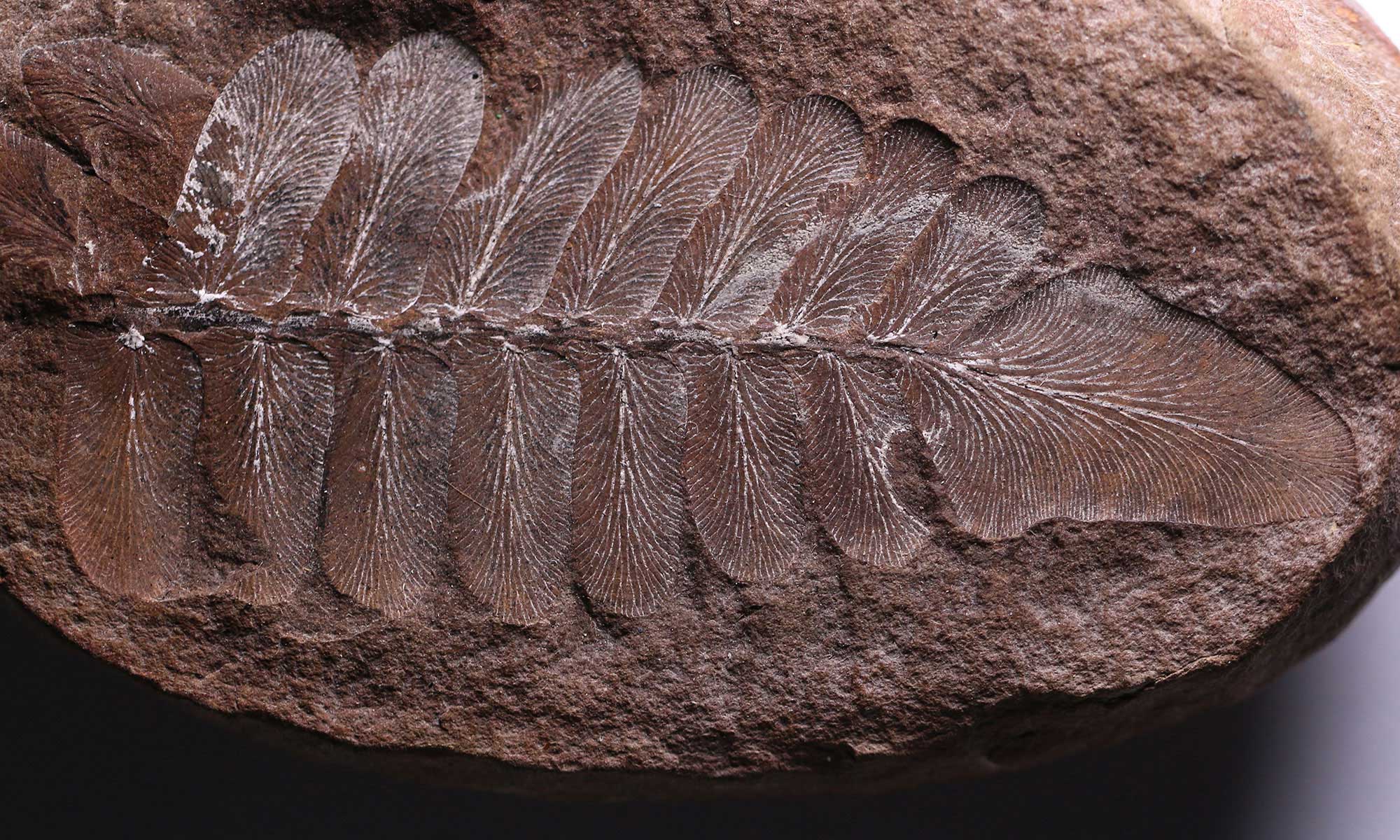50 million-year-old fossil assassin bug has unusually well-preserved genitalia

The fossilized insect is tiny and its genital capsule, called a pygophore, is roughly the length of a grain of rice. It is remarkable, scientists say, because the bug’s physical characteristics – from the bold banding pattern on its legs to the internal features of its genitalia – are clearly visible and well-preserved. Recovered from the Green River Formation in present-day Colorado, the fossil represents a new genus and species of predatory insects known as assassin bugs.
The find is reported in the journal Papers in Palaeontology.
Discovered in 2006 by breaking open a slab of rock, the fossilized bug split almost perfectly from head to abdomen. The fracture also cracked the pygophore in two. A fossil dealer later sold each half to a different collector, and the researchers tracked them down and reunited them for this study.
“Being able to see a bug’s genitalia is very helpful when trying to determine a fossil insect’s place in its family tree,” said Sam Heads, a paleontologist at the Illinois Natural History Survey who led the research with Daniel Swanson, a graduate student in entomology at the University of Illinois Urbana-Champaign.
Cariad Williams, paleontology PhD student

Cariad Williams is pursuing a PhD in entomology at the University of Illinois and is advised by paleontology curator Sam Heads. Read more about her research interests and her path to studying paleontology in this short profile.
National Science Foundation awards more than $480,000 to amber preservation project
The National Science Foundation (NSF) has awarded more than $480,000 to a Prairie Research Institute (PRI) project to preserve and digitize an extensive collection of Dominican amber that is in danger of deterioration without proper curation and care. The plants, arthropods, and vertebrates captured in the amber provide insights into life 16-18 million years ago, during the Early Miocene epoch.
The Milton Sanderson Dominican Amber Collection is the oldest and perhaps largest collection of Early Miocene Dominican amber in the world, consisting of approximately 140,000 pieces collected in 1959 by Illinois Natural History Survey entomologist Milton Sanderson.
“In addition to its sheer size, the Sanderson collection is notable because it’s unbiased,” said project principal investigator Sam Heads, curator and lead paleontologist for the PRI Center for Paleontology. “All other major amber collections are ‘cherry-picked,’ but this amber was collected in bulk from a single locality. Because of this, the collection can provide us with an invaluable snapshot of the biodiversity and ecology of the Dominican amber forest.”
The NSF funding will allow Heads and collection manager Jared Thomas to undertake the urgently needed conservation and curation of the collection. Rediscovered in 2011, the collection had been stored for decades in steel buckets, and during that time it was subjected to temperature and humidity fluctuations. The amber is now extremely fragile, prone to shattering and crumbling.
Digitization efforts make wealth of INHS collections more accessible
The Illinois Natural History Survey, a division of the Prairie Research Institute, is home to over 9 million biological specimens, including plants, insects, fish, reptiles, and fossils. Learn how we’re digitizing these specimens to make them accessible to everyone in this article from the Daily Illini.
Ancient ‘fig wasp’ lived tens of millions of years before figs
 INHS Paleontologist Sam Heads found an ancient fig wasp that pre-dates any known fig trees. According to Heads, “This is a tiny parasitic wasp, it’s the smallest fossil wasp found in this particular deposit and it’s the oldest representative of its family. More importantly, it’s possible that this wasp was fig-associated, which is interesting because it’s Early Cretaceous, about 115 to 120 million years old. That’s a good 65 million years or so prior to the first occurrence of figs in the fossil record.”
INHS Paleontologist Sam Heads found an ancient fig wasp that pre-dates any known fig trees. According to Heads, “This is a tiny parasitic wasp, it’s the smallest fossil wasp found in this particular deposit and it’s the oldest representative of its family. More importantly, it’s possible that this wasp was fig-associated, which is interesting because it’s Early Cretaceous, about 115 to 120 million years old. That’s a good 65 million years or so prior to the first occurrence of figs in the fossil record.”
https://news.illinois.edu/blog/view/6367/204687
Portrait of a killer: Arilus cristatus, the wheel bug
Arilus cristatus, the wheel bug, is a truly impressive insect and one that I was fortunate enough to encounter today on my way into work. I came across this spectacular individual crossing the street outside our building this morning and collected it so I could take some photos later in the lab.
Wheel bugs are a a type of large assassin bug, a diverse group of true bugs in the family Reduviidae. As their name suggests, assassin bugs are deadly predators, feeding voraciously on other arthropods. Like all hemipterans, the mouthparts of assassin bugs consist of a long, segmented tube called a rostrum. Most hemipterans use this piercing apparatus to suck sap from the stems of plants, but the assassin bugs put it to a far more sinister use, empaling their prey and injecting lethal saliva packed with digestive enzymes which liquefy the unfortunate victim’s innards. The nutrient-rich soup is then sucked out with the rostrum acting rather like a straw.
Arilus cristatus and most of the other assassin bugs are beneficial insects, feeding on numerous arthropod pests. While the larger species like the wheel bug can inflict a painful bite when provoked, most reduviids are generally harmless to humans. However, members of the subfamily Triatominae are haematophagous and make a living drinking the blood of vertebrates, including humans. Indeed, triatomines are commonly called “kissing bugs” due to their habit of biting people on the face while they sleep. Unfortunately, they are potential vectors for the parasitic trypanosome that causes Chagas disease, a dangerous tropical illness.
Just published: A new fossil cricket of the genus Proanaxipha in Miocene amber from the Dominican Republic
The following paper was published today in the journal ZooKeys: Heads SW, Penney D, Green DI (2012) A new fossil cricket of the genus Proanaxipha in Miocene amber from the Dominican Republic (Orthoptera: Gryllidae: Pentacentrinae). ZooKeys 229: 111–118, doi: 10.3897/zookeys.229.3678. [pdf]
In the paper we describe Proanaxipha madgesuttonae, a new species of pentacentrine cricket from Early Miocene Dominican amber. The holotype (a male) is exceptionally well preserved, as is typical of inclusions in Dominican amber, and retains its original color pattern and fine setae on the pronotum, legs, cerci, etc. In addition, the apical parts of the phallic complex (the median epiphallic process and the distal lobes of the ectoparameres) can be seen in ventral view, protruding slightly from the genital capsule.
Morphologically, P. madgesuttonae and the type species P. latoca (described by Vickery & Poinar, 1994) share many features in common with some species currently placed in the extant genus Nemobiopsis and while the precise relationships of these taxa have yet to be fully investigated, it seems likely that Proanaxipha and Nemobiopsis are closely related. Nevertheless, the status of Nemobiopsis and Proanaxipha as separate, monophyletic genera is questionable (Nemobiopsis in particular is rather ill-defined) and a thorough revision of these and related genera is needed.
Additional references
Vickery VR, Poinar GO (1994) Crickets (Grylloptera: Grylloidea) in Dominican amber. Canadian Entomologist 126: 13–22, doi: 10.4039/Ent12613-1.

